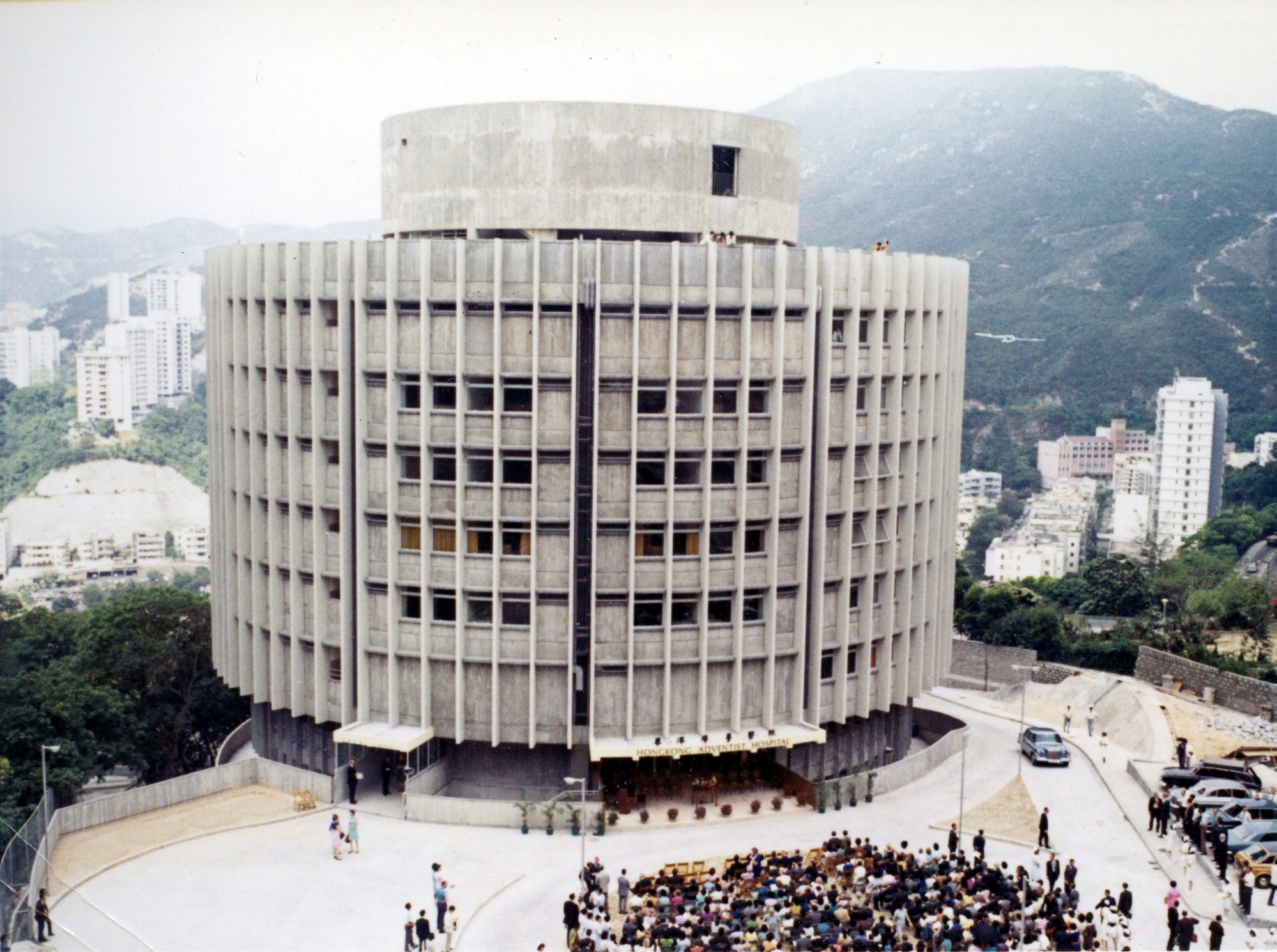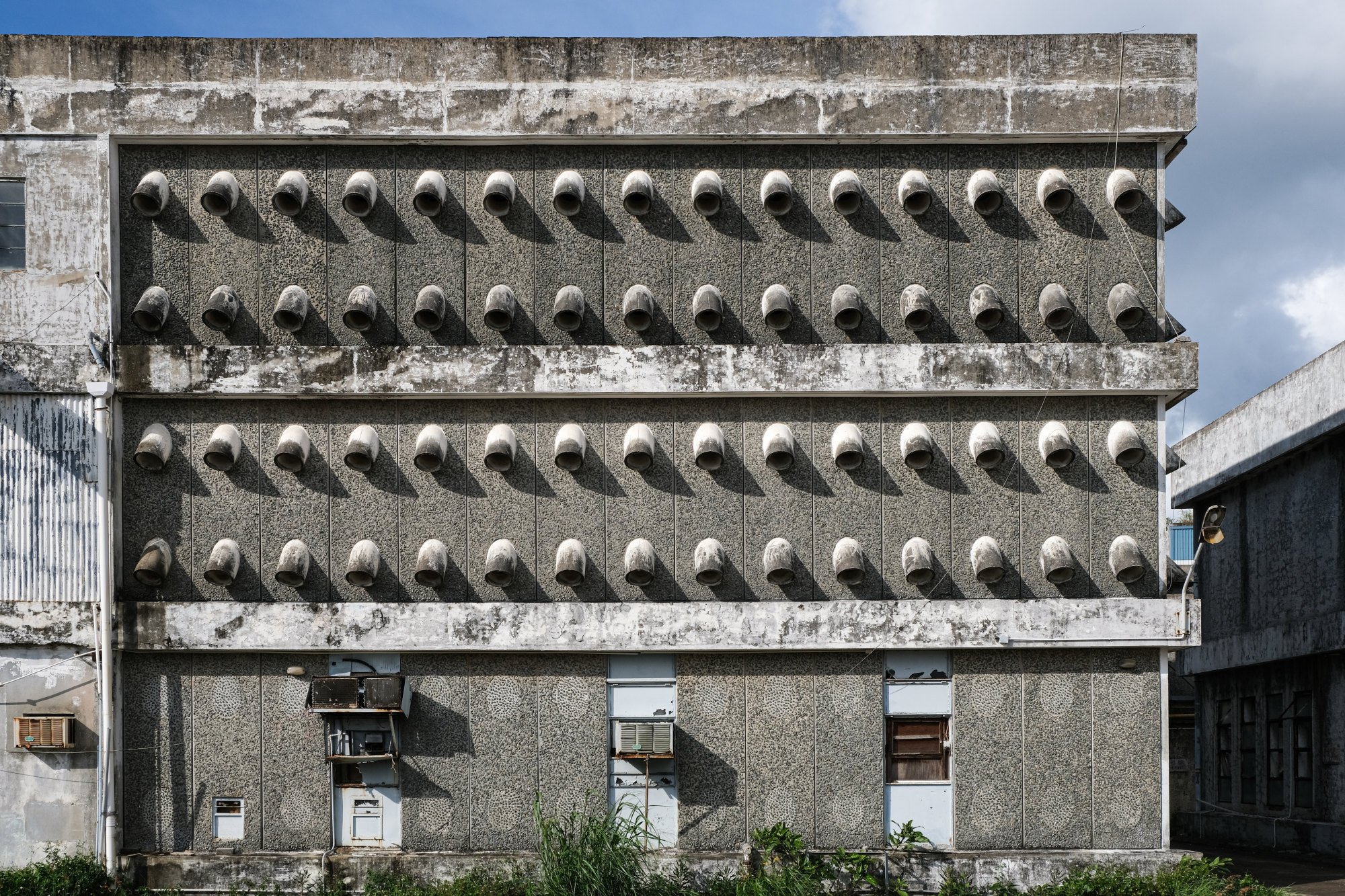
Why Hong Kong’s Brutalist buildings are a vital part of the city’s history, and the group encouraging others to embrace these structures both loved and loathed
- Hong Kong is home to significant Brutalist structures from the 1960s and 70s, including a few still left at Shaw Studios in Clear Water Bay
- To encourage preservation, a group of Hongkongers is working to raise awareness of the architectural style
Zip ties may be among the world’s most useful inventions, but when used to secure a building they send mixed messages. One is a half-hearted “Keep Out”. “Disposable” might be another.
Which is why my spirits droop as I peer through a glass door at the grade three-listed Brutalist Guard House at the Shaw Studios residential blocks in Clear Water Bay.
While realising today is not my lucky day for a close look inside the two-storey cantilevered structure, I recognise, too, that the cheap plastic fastener underscores the vulnerability of the building it purports to protect.
On this steamy afternoon, it feels especially poignant that rot has already set in. Reached by climbing an exterior spiral staircase, the main 180 sq ft (17 square metre) space is a wet, mouldy mess. Its fair-faced concrete surfaces outside are in no better shape: Play-Doh appears to have been slapped into cavities.

But despite the T-shaped building’s decrepitude at 55 years of age, it is not difficult to imagine it in better days, when a tuck shop sold snacks downstairs and a hair salon operated on the light-filled level above.
“Although it has always been called the Guard House, there was no space for guards,” says Bob Pang Chin-wah.
The Hong Kong architect’s explanation adds dimension to images in my head of the building as an Instagrammable lifeguard tower, say, on one of Sai Kung’s beaches.
Raze and rebuild? No, adapt and reuse, Chinese architecture firm says
But Pang has little time for flights of fancy.
He is on a concrete mission to enhance awareness of Hong Kong’s 1960s-70s embrace of Brutalism. Deeper understanding and connection, he hopes, will be accompanied by greater conservation efforts.
His timing is spot on. Hongkongers are increasingly interested in the city’s past. And after years of division about Brutalism’s sometimes monsterish bulk and crude functionality, it is clear modernism’s offspring is enjoying a moment.

As appreciation grows for exposure rather than concealment, the style seems to be finding new appeal for showcasing not only the rugged beauty of concrete but also the structural elements of buildings.
Much else is revealed in Pang’s recently published Unknown Brutalism Architecture in Hong Kong and its accompanying exhibition, a follow-up to an inaugural event in 2021.
In the Chinese-language book, with present-day photographs by Kevin Mak King-huai mixed with old images and architectural drawings, Pang includes buildings extant and expired, from architects past and present. Think those who witnessed the beginnings of Hong Kong-style, high-density living at a time of population explosion, including architects Szeto Wai, Samn Lim and Jackson Wong Chack-sang.

British architect David Russell, who lived in Hong Kong from 1971 to 1990, contributes an essay in the book, as does German Oliver Elser, a curator at Frankfurt’s Deutsches Architekturmuseum whose SOS Brutalism project whet Pang’s appetite for local research several years ago.
“It is all about interweaving new information and knowledge from the 2021 exhibition,” says Pang.

The style was introduced to Hong Kong mainly by Western-educated local architects, although Pang himself was oblivious to it while studying architecture in the early 2000s at the University of Hong Kong.
The Guard House, and the two Shaw Studios residential blocks it served, are among 20 case studies in his book.

In these “dormitories”, which accommodated the self-contained Shaw Movietown community, regular staff lived alongside celebrities, as one of the few remaining long-time residents – a Mrs Kang – tells us in an impromptu meeting.
“Many stars have left their shadows on the staircase,” says Pang, referring to the structure “dancing in the air” at the back of the Guard House. Its precast, reinforced concrete treads now wind their way up to a rooftop that is an accidental planter choked with weeds. In decades past they made a desirable backdrop for photo shoots.

More importantly, for Pang, the Guard House established the architectural style of Ronald Poon Cho-yiu (1942-2022), who would become president of the Hong Kong Institute of Architects and chairman of the Hong Kong Housing Society.
It was Poon’s first built project after graduating from the Architectural Association School of Architecture in London and returning to Hong Kong. Then in his 20s, Poon was also behind the unusual concrete bridge that connects the residential blocks we visit.
“It’s like it’s coming out of the slope,” Pang remarks about the branchlike design of the span, which boasts a single column slanting at the precarious angle of a leaning flame tree nearby. “See the double curve? This would be very difficult for contractors to do – even nowadays. It is so sexy.”

Back in the day, across the road from the accommodation area, there would have stood 20-plus other Shaw Studios buildings, storage facilities included.
Film scenery, for instance, was kept and repaired within a pair of low-maintenance, aggregate-clad buildings designed, on two of three levels, without windows or the need for air conditioning.
Architects celebrate Hong Kong’s unheralded Brutalist buildings
Poon’s then boss, Peter Pun Yen-shou (1931-2016), designed the residential as well as those production-department blocks (one of which succumbed to fire in the 1990s).
“The choice of tubular ventilation units instead of glazing […] was made to ensure a through flow of natural air at all times and so prevent fungus forming on the scenery parts,” reads an article from a 1969 issue of Far East Builder magazine. “This solution, avoiding the expense of mechanical ventilation, has been completely successful.”

In 2021, to make way for future housing, the remaining storage building was levelled, along with much else. But redevelopment plans could not prevent their dramatic return.
Several months later, at Pang’s first exhibition, they were remembered with photographs and artwork inspired by their repetitive rows of vent shafts poking through pre-cast concrete walls. Information served as epitaph.
The event was memorable for another reason. It provided the opportunity for Pang and Poon’s first of two meetings, where new revelations crystallised the younger architect’s objectives.

One is simply to get the facts right.
“He told me our information was wrong,” says Pang, explaining that Poon should be credited with designing the Guard House.
“On paper the whole complex [the two residential blocks plus the Guard House] was designed by Peter Pun. Ronald Poon’s name is not in the Antiquities Advisory Board’s documents.
“One of my missions is to try to rectify this.”

Another is to have the grade-three listing of the Guard House reassessed for higher protection, given its special architectural and historic interest.
Highlighting the urgency is a foundation stone nearby that records Sir David Trench, then Hong Kong governor, presiding over its laying on May 18, 1968. Not only is the plaque cracked but it is barely legible these days, portending irrelevance.
Not if Pang and his growing team of researchers can help it. Their project, sponsored by non-profit organisation Design Trust and Leigh & Orange, has garnered somewhat unexpected levels of public support. At July’s Hong Kong Book Fair, his was the bestselling title on six of the event’s seven days.

Long-standing fans lucky enough to have a copy will recognise the project’s new case studies, alongside the Shaw Studios buildings. They include Szeto Wai’s SAAB Building in Tsuen Wan and the Yau Ma Tei Jockey Club Polyclinic by Leigh & Orange.
Two others are Wong & Ouyang’s Hong Kong Adventist Hospital, in Happy Valley, and Jackson Wong Chack-sang’s 1966 Chung Hom Kok residence. The horizontal band of windows slicing through that three-storey house borrows directly from Le Corbusier’s Villa Savoye, in Poissy, France, as Pang points out in his book.

That Le Corbusier was a direct influence is no coincidence.
The French-Swiss architect, whose Unite d’Habitation in Marseilles is among the most influential Brutalist buildings in the world, is given special mention in the contributing essay by David Russell, now 88.
In a phone conversation from Thailand, where he is based, the British architect says that “Le Corbusier took modernism and turned it into Brutalism”, even though the term itself originated in Britain in the early 1950s.
“Most modern buildings today are Brutalist, but with new clothes, making them appear less brutal,” he says. “They work in the same way.”

Interestingly, during Russell’s near two decades in the colony, he formed a work partnership with Poon, and co-founded the Hong Kong Heritage Society. Among enduring examples of Russell’s projects in the SAR is the tank-proof Hong Kong Note Printing building in Tai Po Industrial Estate that produces the city’s dollar bills.
Today, after years of refusing to call himself a Brutalist architect, he says: “I bear the title with some pride.” But the architect characterises as “soft Brutalism” his own style of architecture and that of many of his peers, who shied from the “outrageous monsters” for which it is remembered.
Russell explains that the name, an unfortunate mistranslation, had much to do with public division. “Le Corbusier described the style as ‘brut’, which in French means […] plain, a bit crude, and simple,” he says.
As to why Brutalism in Hong Kong should be safeguarded, it’s “because it marked the beginning of a new era”.
The Shaw Studios Guard House is an example, plain and simple.
“Unknown Brutalism Architecture in Hong Kong” runs until August 22 at Form Society, 186 Tai Nan Street, Sham Shui Po.

